Bavaria, Liechtenstein & San Marino
The next part of this European adventure involves trains. Hooray for big windows, plenty of legroom, restaurant cars, free wifi, and stations in the center of every city. I bought a Eurail pass. The last time I had a Eurail pass was the summer of ’73 when I backpacked through Europe on $5 a day. Those were the days! Although the world has changed a bit since then, a Eurail pass is still ideal for hopping on a train at the last minute and going wherever you want to go. With train schedules on-line, it’s even easier now than it was half a century ago.
The first part of this railway adventure involved seven overnight stops, twelve trains and 2,186 kms. From Copenhagen, I crossed Denmark, rolled south through Germany, crossed Bavaria to Liechtenstein, and tunneled through the Alps to Italy and San Marino.
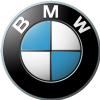
My first stop was Bavaria. Although not an independent country, Bavaria is the largest German state by land area, and it’s home to BMW (Bavarian Motor Works). But I didn’t come here to buy a car. I came here to see the castle that’s said to have inspired Walt Disney’s Sleeping Beauty Castle — the iconic symbol of Disneyland. The castle is near the town of Füssen in southern Germany.
Füssen is an adorable Bavarian town, surrounded by lakes, forests, mountains and castles. As a cultural center, Füssen hosts music festivals. On arrival, I was greeted by folks dressed in dirndls and lederhosen dancing to accordions, horns and tubas.
The next morning, I hiked past two lakes, across a bridge and through a forest to Neuschwanstein Castle. This extravagant palace was intended as a private residence for King Ludwig II. Construction began in 1869, but was never fully completed. In 1886, Ludwig (and his therapist) died mysteriously! Construction ceased. Six weeks later, the castle was opened to the public. Since then, Neuschwanstein has become one of the most popular tourist attractions in Bavaria.
From the valley up to the castle, I took a scenic trail. A footbridge over a nearby canyon is where the well-known photograph to the left can be taken. There’s no fee to walk around the castle and enjoy spectacular views, but the tour of the interior shouldn’t be missed. Leopold spared no expense in decorating his architectural masterpiece. The palace has been beautifully restored and maintained. The original fixtures and furniture are still in place. Photos aren’t permitted in the interior, so you’ll have to click here to see what this palace looks like inside. It’s gorgeous!
Next stop: Liechtenstein, the fourth smallest country in Europe by area, and the third smallest by population. Located along the Rhine between Switzerland and Austria, two-thirds of this country is steep mountains. The highest peak is 2599m. The other third of the country consists of the broad Rhine valley with its vineyards, villages and Vaduz, the diminutive capital. With this topography, Liechtenstein is popular for hiking and biking in summer. and skiing in winter. The wine is good year round.
From Füssen, a train delivered me to the Swiss (western) bank of the Rhine. Crossing the river on a footbridge, I was greeted by three flags. Ironically, except for the golden crown which was added in 1937, the flag of Liechtenstein is almost identical to the flag of Haiti. Yet, these two countries could not be more different. Liechtenstein has one of the world’s highest GDPs per capita. Its citizens enjoy one of the highest standards of living in the world. Although Liechtenstein is no longer blacklisted as an extralegal tax haven, one of its primary industries is financial services for billionaires.
In Vaduz, I met up with my occasional travel partner Bart, whom I last saw in Guadeloupe in May. Bart hadn’t been to Liechtenstein for many years, so he figured it was time to see if anything has changed here. It hasn’t.
Prince Hans-Adam II, the world’s sixth wealthiest monarch with an estimated net worth of $3.5 billion, is still the reigning monarch of Liechtenstein. A photo of one of his well-tended vineyards is shown to the right.
Liechtenstein is a safe, quiet and scenic country where the locals celebrate their traditions by wearing costumes like the woman to the left.
A wide bike path runs the length of the country along the Rhine. It’s only 25 km from the north end of the country to the south. So, one can pedal the length of Liechtenstein in an hour. In contrast, biking east-west across the country is nearly impossible because it requires going over a pass of almost 2000 meters on gravel roads and dirt trails. In the photo to the right, the sun setting behind the Alps casts a rosy glow on the mountains.
Vaduz Castle, overlooking the capital, is closed to the public because it’s the residence of Prince Hans-Adam II. Once a year the castle is open to everyone on Liechtenstein National Day, August 15. On that day, every Liechtensteiner is invited into the Prince’s home for feasts and fireworks. I was tempted to stick around for a week to see if I could get a free pass into the castle. I’ll bet it’s a good party.
My last stop was the Republic of San Marino, a walled, mountaintop city enclaved by Italy. This is Europe’s third smallest country after Vatican City and Monaco. This is a prosperous country with a GDP per capita equivalent to Italy. Although not a member of the EU, San Marino’s official currency is the euro. With 1.6 cars for every resident (including children), San Marino is the only country in the world that has more cars than people.
San Marino is an ancient settlement. Perched on top of an impregnable 739m high limestone outcrop called Mount Titano, this city has successfully defended its independence ever since it broke away from the Roman Empire in 301 AD. Since 1463, the country’s borders have remained unchanged. Its constitution dates back to 1600. Today, financial services, electronics, ceramics and tourism are San Marino’s key industries. San Marino’s postage stamps are sold to philatelists for an additional source of income for the country.
As with my last few posts, I’ve been lucky to have a dear friend whom I could call upon to be my guide and interpreter for this country. Here’s Anna whom I met at Aviano Air Base in 1981 when we were both employed as teachers. Thank you, Anna, for a wonderful visit to San Marino!
Like Liechtenstein, San Marino makes an effort to preserve its unique landscape and culture, including the uniformed Fortress Guards who protect the Palazzo Pubblico, the national seat of government.
People come from all over Europe to visit this charming mountaintop destination. The cobblestone streets and medieval fortress walls reek of history, while the souvenir shops sell the latest chachkas and restaurants provide free wifi. With a lower tax rate than surrounding Italy, gasoline and alcohol is cheaper here than in Italy, yet San Marino’s hotels are quite expensive. So, I stayed at a delightful AirBnB in the nearby village of San Leo.
The summit of Mount Titano is 20 kilometers from the Adriatic Sea, which can be viewed from any of San Marino’s towers and fortress walls.
Although Bavaria ceased being an independent country in the XIX century, Leichtenstein and San Marino are members in good standing in the United Nations. So, I can count them as countries visited. With my San Marino visa in my passport, this makes country #166. I have a long way to go and some difficult countries still to visit, but this short series of stops has been fun and easy.
From Italy, I’m heading northeast towards the Baltic states and Finland. Anyone want to join me?


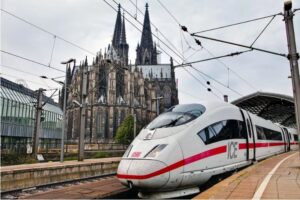

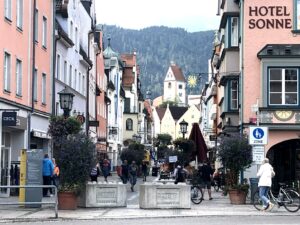
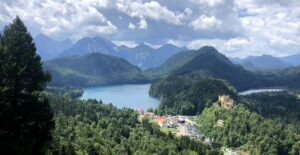
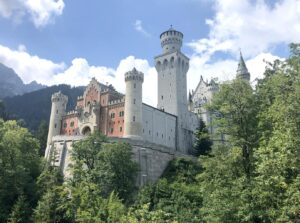
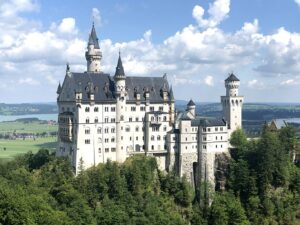
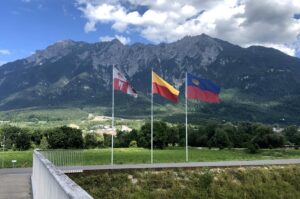
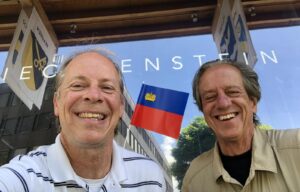
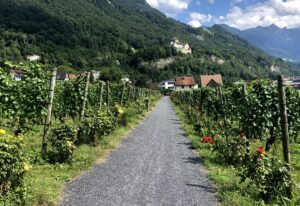
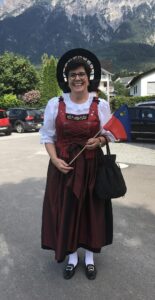
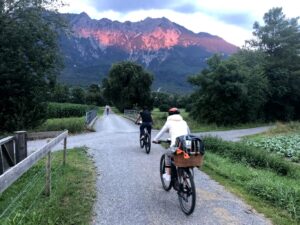
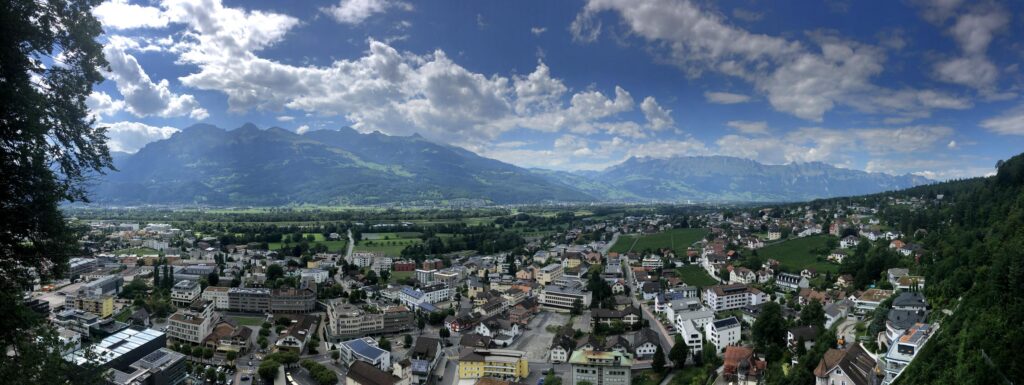

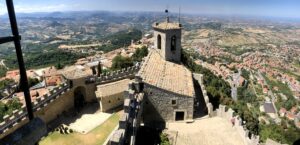
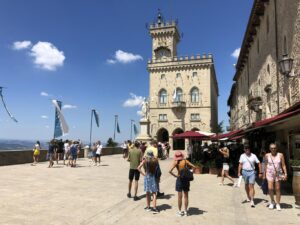
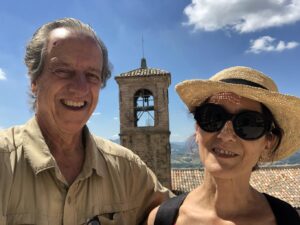
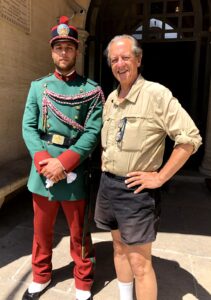
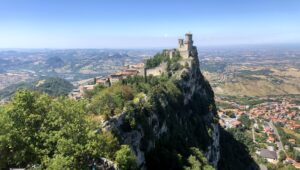
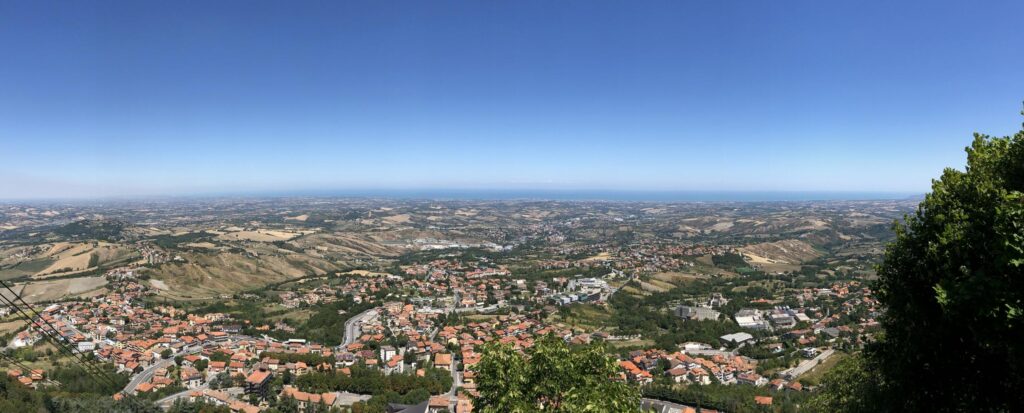
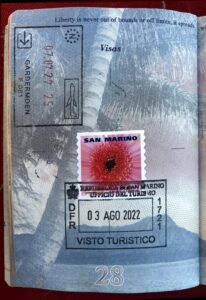
Love the futuristic train picture. Futuristic if you live in the US.
Went to Neushwanstein in Bavaria in 1970! Truly a beautiful castle (King Ludwig’s house)!!!
Suzi
I’m in Prague with my family…enjoying the wonderful change in the weather…much cooler than just 3 days ago. My wife and I have been here twice before, but my daughter and her family are visiting for the first time. Life is good…keep traveling and posting about your travels.
Sounds like a great trip. I’m going to Germany on August 15 to see friends in Stuttgart, and on to Lisbon on August 21. Maybe then back to the States. Liked your comments.
Keep on truckin’, brother.
That amazing castle! Can you say, “CHITTY CHITTY BANG BANG”? There, I knew you could!
Hi Nick,
I knew that castle as I had been there as a young girl with my family! I thought of Chitty, Chitty Bang Bang too!
I love the pics you include in your blogs, and the friends that accompany you too. Ingrid
I enjoy the teaser-photographs and links in your text. Thanks.